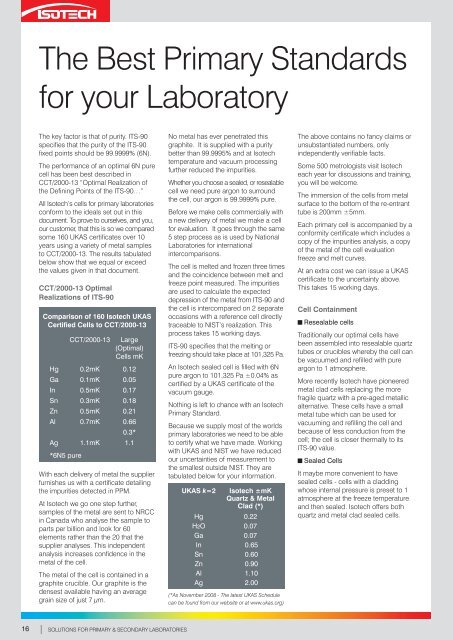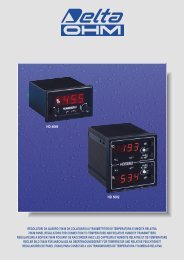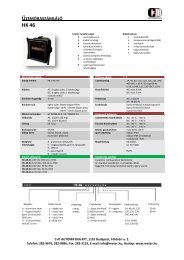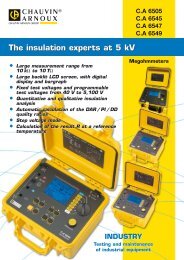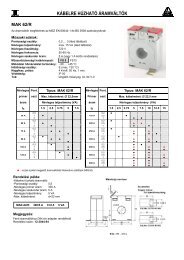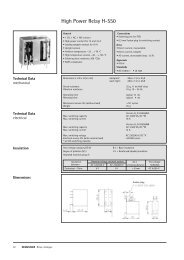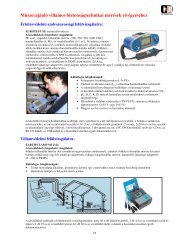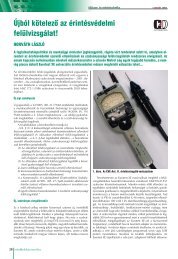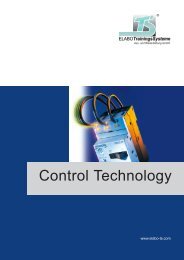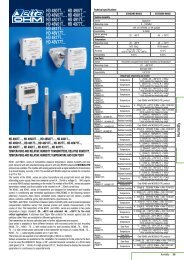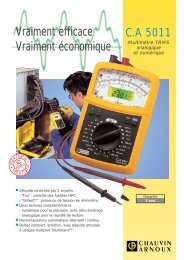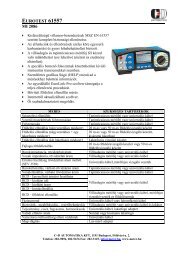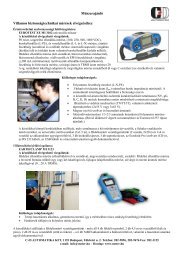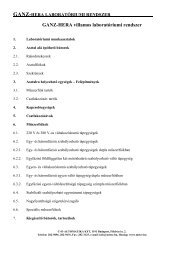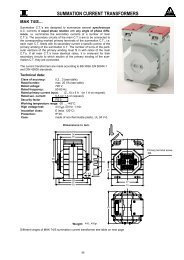Solutions for Primary & Secondary Laboratories
Solutions for Primary & Secondary Laboratories
Solutions for Primary & Secondary Laboratories
You also want an ePaper? Increase the reach of your titles
YUMPU automatically turns print PDFs into web optimized ePapers that Google loves.
The Best <strong>Primary</strong> Standards<br />
<strong>for</strong> your Laboratory<br />
The key factor is that of purity. ITS-90<br />
specifies that the purity of the ITS-90<br />
fixed points should be 99.9999% (6N).<br />
The per<strong>for</strong>mance of an optimal 6N pure<br />
cell has been best described in<br />
CCT/2000-13 “Optimal Realization of<br />
the Defining Points of the ITS-90…”<br />
All Isotech’s cells <strong>for</strong> primary laboratories<br />
con<strong>for</strong>m to the ideals set out in this<br />
document. To prove to ourselves, and you,<br />
our customer, that this is so we compared<br />
some 160 UKAS certificates over 10<br />
years using a variety of metal samples<br />
to CCT/2000-13. The results tabulated<br />
below show that we equal or exceed<br />
the values given in that document.<br />
CCT/2000-13 Optimal<br />
Realizations of ITS-90<br />
Comparison of 160 Isotech UKAS<br />
Certified Cells to CCT/2000-13<br />
CCT/2000-13<br />
Large<br />
(Optimal)<br />
Cells mK<br />
Hg 0.2mK 0.12<br />
Ga 0.1mK 0.05<br />
In 0.5mK 0.17<br />
Sn 0.3mK 0.18<br />
Zn 0.5mK 0.21<br />
Al 0.7mK 0.66<br />
0.3*<br />
Ag 1.1mK 1.1<br />
*6N5 pure<br />
With each delivery of metal the supplier<br />
furnishes us with a certificate detailing<br />
the impurities detected in PPM.<br />
At Isotech we go one step further,<br />
samples of the metal are sent to NRCC<br />
in Canada who analyse the sample to<br />
parts per billion and look <strong>for</strong> 60<br />
elements rather than the 20 that the<br />
supplier analyses. This independent<br />
analysis increases confidence in the<br />
metal of the cell.<br />
The metal of the cell is contained in a<br />
graphite crucible. Our graphite is the<br />
densest available having an average<br />
grain size of just 7 µm.<br />
No metal has ever penetrated this<br />
graphite. It is supplied with a purity<br />
better than 99.9995% and at Isotech<br />
temperature and vacuum processing<br />
further reduced the impurities.<br />
Whether you choose a sealed, or resealable<br />
cell we need pure argon to surround<br />
the cell, our argon is 99.9999% pure.<br />
Be<strong>for</strong>e we make cells commercially with<br />
a new delivery of metal we make a cell<br />
<strong>for</strong> evaluation. It goes through the same<br />
5 step process as is used by National<br />
<strong>Laboratories</strong> <strong>for</strong> international<br />
intercomparisons.<br />
The cell is melted and frozen three times<br />
and the coincidence between melt and<br />
freeze point measured. The impurities<br />
are used to calculate the expected<br />
depression of the metal from ITS-90 and<br />
the cell is intercompared on 2 separate<br />
occasions with a reference cell directly<br />
traceable to NIST’s realization. This<br />
process takes 15 working days.<br />
ITS-90 specifies that the melting or<br />
freezing should take place at 101,325 Pa.<br />
An Isotech sealed cell is filled with 6N<br />
pure argon to 101,325 Pa ±0.04% as<br />
certified by a UKAS certificate of the<br />
vacuum gauge.<br />
Nothing is left to chance with an Isotech<br />
<strong>Primary</strong> Standard.<br />
Because we supply most of the worlds<br />
primary laboratories we need to be able<br />
to certify what we have made. Working<br />
with UKAS and NIST we have reduced<br />
our uncertainties of measurement to<br />
the smallest outside NIST. They are<br />
tabulated below <strong>for</strong> your in<strong>for</strong>mation.<br />
UKAS k=2 Isotech ±mK<br />
Quartz & Metal<br />
Clad (*)<br />
Hg 0.22<br />
H2O 0.07<br />
Ga 0.07<br />
In 0.65<br />
Sn 0.60<br />
Zn 0.90<br />
Al 1.10<br />
Ag 2.00<br />
(*As November 2008 - The latest UKAS Schedule<br />
can be found from our website or at www.ukas.org)<br />
The above contains no fancy claims or<br />
unsubstantiated numbers, only<br />
independently verifiable facts.<br />
Some 500 metrologists visit Isotech<br />
each year <strong>for</strong> discussions and training,<br />
you will be welcome.<br />
The immersion of the cells from metal<br />
surface to the bottom of the re-entrant<br />
tube is 200mm ±5mm.<br />
Each primary cell is accompanied by a<br />
con<strong>for</strong>mity certificate which includes a<br />
copy of the impurities analysis, a copy<br />
of the metal of the cell evaluation<br />
freeze and melt curves.<br />
At an extra cost we can issue a UKAS<br />
certificate to the uncertainty above.<br />
This takes 15 working days.<br />
Cell Containment<br />
g Resealable cells<br />
Traditionally our optimal cells have<br />
been assembled into resealable quartz<br />
tubes or crucibles whereby the cell can<br />
be vacuumed and refilled with pure<br />
argon to 1 atmosphere.<br />
More recently Isotech have pioneered<br />
metal clad cells replacing the more<br />
fragile quartz with a pre-aged metallic<br />
alternative. These cells have a small<br />
metal tube which can be used <strong>for</strong><br />
vacuuming and refilling the cell and<br />
because of less conduction from the<br />
cell; the cell is closer thermally to its<br />
ITS-90 value.<br />
g Sealed Cells<br />
It maybe more convenient to have<br />
sealed cells - cells with a cladding<br />
whose internal pressure is preset to 1<br />
atmosphere at the freeze temperature<br />
and then sealed. Isotech offers both<br />
quartz and metal clad sealed cells.<br />
16 | SOLUTIONS FOR PRIMARY & SECONDARY LABORATORIES


